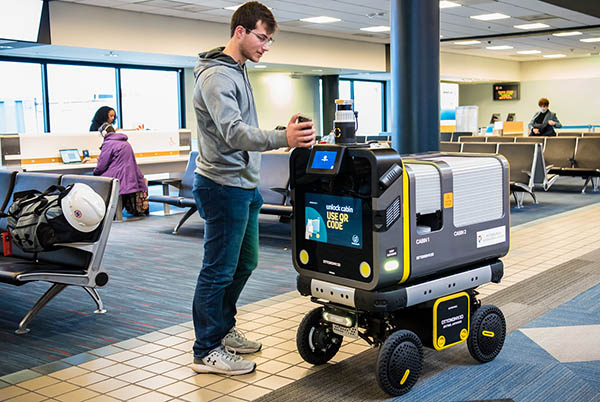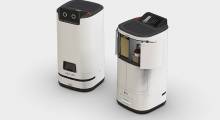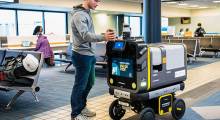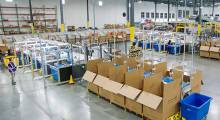Airports are home to a variety of industries and businesses. Airside operations function alongside cargo and baggage ground handling logistics. Customer-facing terminals house security checkpoints and retail outlets. Runways, taxiways, ramps, and large grass fields make up most of the land area, while restaurants and stores inside terminals are compressed into expensive real estate.
“When I think of an airport, it's like a small city,” said Cole Wolfson, director of the xBridge innovation center at Pittsburgh International Airport (PIT). “There's just about every industry that you can think of that operates here. And so there's boundless opportunities to find new and better, or more efficient ways of doing things.”
As the director of xBridge, Wolfson helps innovative technologies spread their wings and find practical use cases to perch on. With such a diversity of spaces connected by complex technical operations, there’s always room for growth and improvement.
Real-world deployment testing offered by xBridge
Unlike other automation opportunities, where companies seek a solution for their operational challenges, xBridge is not demand-driven based on the needs of the airport. Wolfson said xBridge approaches innovative technology candidates not by asking what problems they can solve for PIT, but instead offers a resource to develop technology and explore potential applications.
“We're kind of doing it backwards,” he said. “Instead we're saying, ‘Hey, we have a resource here. Come on tech, you come here and take advantage of that resource.’
The xBridge works with companies to deploy prototypes, perform testing in real-world operating environments, and develop new products and services.
“The way that we work with companies is we essentially tell them, ‘Hey, the door’s open here,” Wolfson said. “And in doing so, we're bringing in the people that operate the airport to kick the tires on these technologies and say, ‘You know, if you took this and turned it five degrees this way, that could have a really interesting opportunity in the airport,’ that the company founders or directors hadn't thought of.”
Wolfson said the first collaboration step - especially for off-airfield technologies - is developing a technical proof of concept to ensure the technology will work within PIT’s operating environment. From there, they perform a business use case pilot to evaluate if the technology can deliver its expected value.

Wolfson said xBridge tests and deploys new technologies not just for PIT’s benefit - also the aviation industry at large - as a means of improving customer, employee, and partner experiences.
Some companies specifically targeting aviation applications have deployed robots within the airfield perimeter. “These companies are a lot more intentional in their commitment to the aviation industry as a market,” Wolfson said.
Because they could not yet perform autonomous operations on the active airfield, one company tested its autonomous aircraft servicing technology on a mock-up fuselage. Wolfson said two companies xBridge is working with currently are approaching baggage operations from two very different perspectives.
While some companies have targeted aviation-specific applications, others had success deploying within more generalized spaces at PIT. Wolfson said xBridge also tests and deploys new technologies and materials that have not yet entered the aviation industry. “We're not necessarily looking for tech that is trying to sell into aviation, but rather tech that can have some sort of impact on the aviation industry.”
Applications on the customer-facing side of the airport include retail outlets, food and beverage operations, and moving people around the campus.“Actions that widely occur within an airport lend [themselves] to all sorts of generalized robotic applications that already exist in the world,” he added.
Wolfson said one company had proven several use cases for its autonomous delivery technology, and utilized xBridge to test out aviation as a potential market. That company is called Ottonomy.
Ottonomy finds applications for autonomous delivery robots
Before starting Ottonomy, CEO Ritukar Vijay worked for a company called Aptiv in Germany, leading the development of BMW’s urban autonomous cars. He realized creating a viable business model would require more time to develop the technology, sort out legality, and change public perceptions.
“That's how we thought, ‘Where can these autonomous systems help?’ Vijay said. “And we focused around the delivery space, which was not so crowded. But, there were whitespaces because most of the delivery robots are heavily dependent on GPS positions and doing outdoors, they're small, they're modular. So that's how we started doing delivery robotics as a mainstream business.”
Vijay said labor shortages and rising hourly wages make goods-to-person deliveries a good candidate for automation. Technology presents an opportunity to alleviate the impacts of labor challenges on businesses, allowing human employees to do more tasks that involve decision making while automating other functions. “You're not removing people, but we are just filling in the gap,” Vijay added.
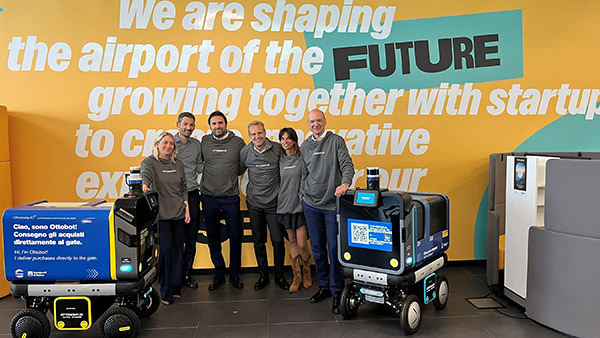
Ottonomy’s Ottobot autonomous mobile robot (AMR) platform is designed to operate across a variety of indoor and outdoor scenarios. One application the company targets is intralogistics, especially for manufacturing and warehousing industries. Vijay said large facilities currently use road vehicles to transport parts and supplies between buildings. “It's not the cost of the vehicle, but it's the cost of the person who's driving it,” he said.
Ottobots are suitable for hyperlocal curbside last-mile package and parcel deliveries, as well as food and beverage delivery at large public hospitality spaces, such as airports, malls, and casinos. Although different delivery environments might be similar, Vijay said workflows vary depending on the commodities being transported. For example, perishable commodities and food orders need to be delivered within a limited timeframe, while mailed packages can be delivered by the end of the day.
Ottonomy has deployed its robots to customers across the United States, Europe, and Middle East, most recently expanding into Singapore. Cincinnati International Airport (CVG) was the company’s first airport deployment.
Ottobots are now live at Leonardo da Vinci–Rome Fiumicino Airport (FCO) in Italy. “Their corporate venture arm also invested in us, so that's a great validation,” Vijay said, adding that airports across the globe become value-added partners for the company. “They help us grow in those particular markets.”
Airports provide multiple use cases for Ottonomy
Airports are a good testing ground for delivery robots because they have some level of control. “People won't do really crazy crazy stuff,” Vijay said, “But at the same time, it has its own dynamicity.
“Some people will stop and interact with the robots, while others might not even notice them as they run to catch a flight.
He added airports across the globe are similar, which allows customer behaviors and problems to be replicated. “Running in public space also adds real value. It's different from a warehouse, where everything is controlled,” Vijay said. “But it is also different from a city where even the infrastructure has its own variations.”
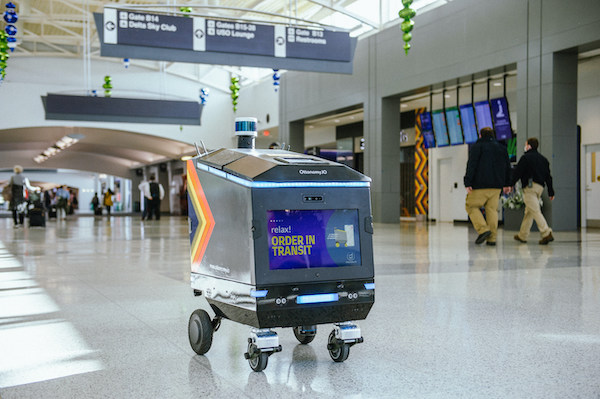
With business to consumer (B2C) deliveries, customers waiting at departure gates can order items from vendors within terminals, and those items are delivered directly to them. Vijay said B2C deliveries open up the reach of retailers and restaurants who are geographically far from certain gates by providing an additional distribution channel, allowing them to reach customers who don’t want to walk across terminals to shop and dine.
Ottobots also fulfill storefront replenishment roles. Vijay said airport terminal real estate is expensive, causing businesses to store their products in distant parts of the airport - sometimes more than half a mile away.
An auxiliary function of Ottonomy’s robots is data collection and inspection, specifically to monitor health as well as security. Vijay said with regards to communicable diseases, such as with the COVID-19 pandemic, monitoring health conditions can help airports prevent further spread.
Dynamic assignment can provide wholesome ROI
A cloud-based scheduler assigns orders to each robot. Vijay said the scheduler accounts for the battery charge levels, which robots are in closest proximity, and maximum utilization of onboard space. With multiple lockers on each robot, Ottobots can perform multiple deliveries during the same trip through order batching.
Vijay said the top platform of Ottonomy’s robots can be customized for each application, allowing specialized equipment or different compartments to be added. When equipped with the right compartments, dynamic assignment allows Ottobots to change from one workflow to another based on demand.
At airports, Ottobots can deliver B2C orders during peak times, and then switch to store replenishment roles when there is less retail customer demand without changing the compartments. Vijay said dynamic assignment allows better asset utilization based on where and how Ottobots can be used, all while collecting security and health data.
“That makes it a wholesome ROI for everybody,” he said. “The underlying technology is the same, so our effort has gone into standardizing the operations.”
Decentralized communication systems provide interoperability, allowing Ottobots to interact with infrastructure elements - such as traffic lights, automated doors, and elevators - as well as robot-to-robot communication. Centralized communication through a browser-based network operations console provides airport administrators with monitoring capabilities. The console also allows telemetry, navigation, and operational data to be collected and even shared with other robots.

Vijay said during initial deployment, only one or two robots are needed to map the operating environment, sharing the data with other robots through the network. Over the course of a few days, Ottonomy’s robots use 3D lidar sensors and cameras to collect both geometric and semantic data to produce a high-information map that provides primary navigation information for the robots.
During the mapping process, Ottonomy works with airports to set up no-go zones that robots need to avoid, such as staircases and moving sidewalks. They also provide tools for airport operators to add or modify restricted areas at a later stage.
While all the navigation is achieved through edge computing, Ottonomy can create a digital twin map as a post-process product which can be used for other purposes. The company’s robots are suitable for brownfield deployments because they do not require any external beacons or other infrastructure for navigation. Multimodal sensors allow the same software stack to provide navigation indoors and outdoors - even around aircraft.
Onboard each Ottobot, contextual AI allows the robot to determine where it is and where it needs to go next. Vijay said robots with a use case to engage with people will move toward crowds, while those performing deliveries will avoid them. Contextual AI enables Ottobots to recognize and respond differently to elderly people, pets, children, and people looking at their phones, for example.
“It's not just about detecting people or classifying them, but also it's very important to understand what they're doing,” he said. “Those are the things which create a good testing ground for us, and that's why airports are super interesting.”
Ottonomy’s goal is to provide fully autonomous operation, but if robots become surrounded by people or encounter an emergency situation, they can be controlled remotely through teleoperation.
PIT and xBridge host Future Travel Experience conference
Vijay said Ottonomy has a very active engagement with PIT through xBridge. “We ran the robots last year, and now we are working with them to unlock some other use cases within the airport.”
He added xBridge helps Ottonomy explore potential applications by bringing together different companies. “There's so many possibilities there, and it's difficult to do all by ourselves,” he said. One scenario xBridge helped Ottonomy test out was mounting a beer dispenser from Cooler Keg and credit card reader on an Ottobot.
Vijay said he is thankful for Ottonomy’s airport customers, especially PIT and xBridge. “They are forward looking,” he said. “That is something which I think becomes a reference point for all airports across the globe.”
Wolfson said xBridge can help the aviation industry access emerging technology. “The Pittsburgh Airport has firmly placed this flag as a leader within the industry when it comes to the deployment of new technologies,” he said.
Wolfson mentioned that the University of Pittsburgh and Carnegie Mellon provide top-ranked robotics programs. “It's kind of a natural match if you have this in your own backyard.”
With access to education, research, and deployment facilities, PIT recently hosted the second annual Future Travel Experience (FTE) conference.

Christina Cassotis, CEO of PIT, said the airport is an ideal location for the FTE conference because of its focus on emerging technologies, passenger experience, and operational excellence.
“The airport and our region provide the perfect setting for showcasing the latest trends and developments in the future of travel,” she said. “It’s our hope that this conference sparks further collaboration between the aviation and robotics communities in a variety of areas.”
The Henry L. Hillman Foundation recently contributed a $75,000 grant, which Cassotis said will allow the foundation, PIT, and FTE to select an idea from the conference to move forward to the next stage of development.
Cassotis said the vision behind xBridge was to create a platform where technology startups, entrepreneurs, and established companies can collaborate and test new ideas. As a result, PIT has benefitted by implementing systems that enhance the passenger experience and improve operations, all while fostering partnerships with technology companies and airlines.
“Working with robotics and tech companies is part of PIT’s larger organizational philosophy that an airport should be part of its community,” Cassotis said. “PIT is not just the gateway to the region - we want to bring forward its best assets.”
Future applications in airport terminals, reverse logistics
Wolfson said large-scale adoption of robotic systems in the aviation industry is limited because both aviation and robotics companies need to more fully understand needs and requirements of certain applications. It’s more than just technical questions about how to make the robots work.
“How would you price a robotic solution so that it actually makes sense in that environment?” Wolfson said. “How do you craft the business around this that will actually move the needle for the industry?”
While aviation companies realize that processes can be automated, robotics companies might ask if the cost and time to develop a solution is worthwhile. Wolfson said a better method is to address the biggest pain points and bottlenecks, integrating with current processes, and then determine if another iteration of automation is necessary.
“I think that the quick, low-hanging fruit within aviation is going to be anything that happens outside of the airfield,” Wolfson said. “I think we're going to start seeing all sorts of roboticized operations when it comes to that flying experience, because, again, I think the market opportunity is much broader than just aviation, and I think that the barrier to entry is lower.”
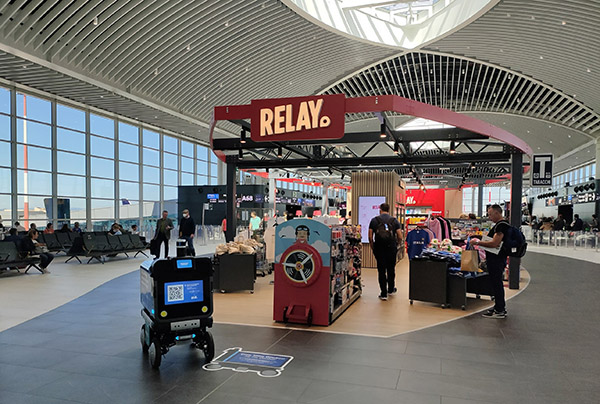
Vijay expects robots will continue to help airport staff create a better customer experience in the future. “These are public robots - they are moving in public areas, interacting with people - but yet solving core business problems.”
Automating ecommerce returns is one application where Ottonomy can help people live better lives in the future. Instead of reverse logistics shipping, or bringing returns to a specific place, people will be able to summon lockers to their homes.
“Five years from now these things are going to be the way of life,” he said. “The real estate value of a particular area will be dependent on what technologies they have.”
Vijay said robots entering consumer applications mirrors the rise of smartphones in the 2010s “Every decade or 15 years there’s a big transition that’s happening,” he said. “Robots - especially public robots - are something where we are in the middle of it.”
Want to learn more about fleet management? This article was featured in the June 2024 Robotics 24/7 Special Focus Issue titled “Orchestrating mobile robot fleets for success.”
About the Author
Follow Robotics 24/7 on Linkedin
Article topics
Email Sign Up

